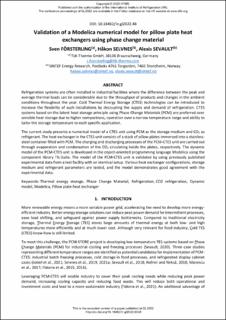| dc.contributor.author | Försterling, Sven | |
| dc.contributor.author | Selvnes, Håkon | |
| dc.contributor.author | Sevault, Alexis | |
| dc.date.accessioned | 2022-11-03T13:11:28Z | |
| dc.date.available | 2022-11-03T13:11:28Z | |
| dc.date.created | 2022-10-13T11:18:47Z | |
| dc.date.issued | 2022 | |
| dc.identifier.citation | 15th IIR-Gustav Lorentzen Conference on Natural Refrigerants - GL2022 - Proceedings - Trondheim, Norway, June 13-15th 2022 | en_US |
| dc.identifier.isbn | 978-2-36215-045-6 | |
| dc.identifier.issn | 0151-1637 | |
| dc.identifier.uri | https://hdl.handle.net/11250/3029923 | |
| dc.description.abstract | Refrigeration systems are often installed in industrial facilities where the difference between the peak and average thermal loads can be considerable due to the throughput of products and changes in the ambient conditions throughout the year. Cold Thermal Energy Storage (CTES) technologies can be introduced to increase the flexibility of such installations by decoupling the supply and demand of refrigeration. CTES systems based on the latent heat storage principle using Phase Change Materials (PCM) are preferred over sensible heat storage due to higher compactness, operation over a narrow temperature range and ability to tailor the storage temperature to each specific application. The current study presents a numerical model of a CTES unit using PCM as the storage medium and CO2 as refrigerant. The heat exchanger in the CTES unit consists of a stack of pillow plates immersed into a stainless-steel container filled with PCM. The charging and discharging processes of the PCM-CTES unit are carried out through evaporation and condensation of the CO2 circulating inside the plates, respectively. The dynamic model of the PCM-CTES unit is developed in the object-oriented programming language Modelica using the component library TIL-Suite. The model of the PCM-CTES unit is validated by using previously published experimental data from a test facility with an identical setup. Various heat exchanger configurations, storage medium and refrigerant parameters are tested, and the model demonstrates good agreement with the experimental data. | en_US |
| dc.description.abstract | Validation of a Modelica numerical model for pillow plate heat exchangers using phase change material | en_US |
| dc.language.iso | eng | en_US |
| dc.publisher | IIR | en_US |
| dc.relation.ispartof | 15th IIR-Gustav Lorentzen Conference on Natural Refrigerants - GL2022 - Proceedings - Trondheim, Norway, June 13-15th 2022 | |
| dc.relation.ispartofseries | Science et technique du froid; | |
| dc.relation.ispartofseries | Science et technique du froid; | |
| dc.title | Validation of a Modelica numerical model for pillow plate heat exchangers using phase change material | en_US |
| dc.title.alternative | Validation of a Modelica numerical model for pillow plate heat exchangers using phase change material | en_US |
| dc.type | Chapter | en_US |
| dc.type | Peer reviewed | en_US |
| dc.description.version | acceptedVersion | en_US |
| dc.rights.holder | Copyright © 2022 IIF/IIR. Published with the authorization of the International Institute of Refrigeration (IIR). The conference proceedings of GL2022 are available in the Fridoc database on the IIR website at www.iifiir.org | en_US |
| dc.identifier.cristin | 2061080 | |
| dc.relation.project | Norges forskningsråd: 308847 | en_US |
| dc.source.articlenumber | 0048 | en_US |
| cristin.ispublished | true | |
| cristin.fulltext | postprint | |
| cristin.qualitycode | 1 | |
